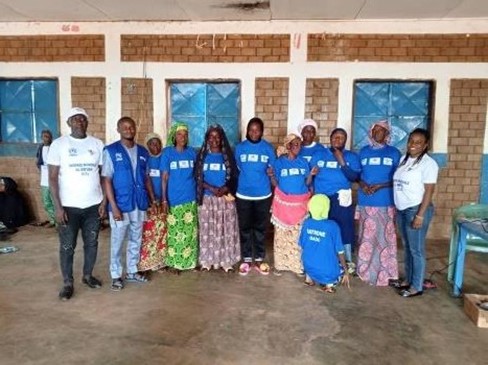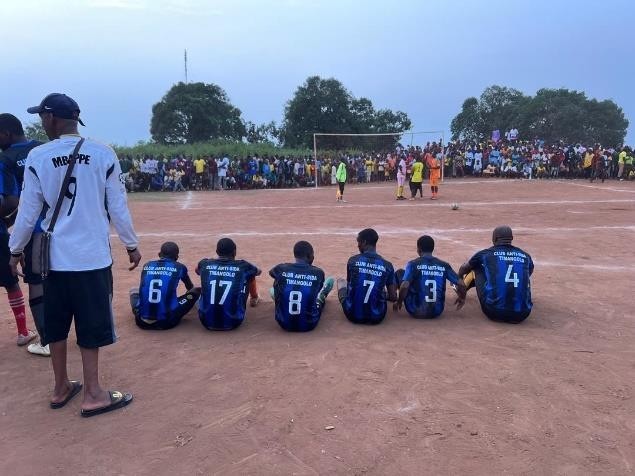Through the 3rd quarter of 2024, among the refugees, nationals, and children consulted, according to recorded data from all the health facilities supported by AHA Cameroon, malaria is the leading cause of morbidity, accounting for more than 25%. Respiratory infections and verminosis combined account for about 25%. Activities and campaigns to support different community groups and promote the prevention of Monkeypox (Mpox) and HIV/AIDS through education and, social activities such as soccer matches were organized by AHA Cameroon.
Activities
Support to different community groups
As part of the strengthening of community intervention, community health workers and various groups and sub-groups were supported with work tools, mobilization/awareness-raising materials and visibility.
Each community health worker received a work tool kit consisting of an umbrella, a pair of boots, a bag, a notebook, 2 pens, a vest, a booklet on HIV/AIDS and other STIs, and 2 leaflets on HIV/AIDS and other STIs.
The anti-AIDS clubs received mobilization equipment consisting of balafon and drums, footballs, sport jersey and sound equipment.
MPox Awareness Raising
Staff members, refugees and host communities were trained and reached through group information sessions and door-to-door awareness campaigns on Mpox.
Organization of HIV/AIDS Campaigns
Despite experiencing difficulties related to the lack of HIV screening tests and condoms, we advocated with Regional Technical Group (GTR) and United Nation Population Fund (UNFPA) and were able to obtain 2,500 condoms and 600 HIV tests. This allowed us to organize a campaign at the Mbile site and Timangolo, involving the refugees, host population, and partners. The mobilization centered around a soccer match that competed the team of Mbile against that of Lolo. This match ended in the victory of the young people of Mbile with 2 goals to 0. On the Timangolo side, the anti-AIDS club played two games. The match between them and the team from Ketté, in the capital of the commune of Ketté, ended in the victory of the refugees from the Timangolo site.
During these campaigns, there was awareness-raising on various themes of HIV health, the distribution of condoms, STI and HIV screening, and awareness-raising on universal health coverage (UHC). A total of 2,129 people were reached, 334 people were tested voluntarily, 26 people were screened for syphilis, and 5 for Hepatitis B, with no positive cases recorded. Additionally, 780 male condoms were distributed, and 122 refugees were pre-enrolled for universal health coverage.
Project Updates
All the health facilities supported by AHA recorded a total of 5,645 consultations for refugees, nationals, and children under 5. Malaria remains the leading cause of morbidity (26.2% of all morbidity), followed by respiratory infections (16.2%) and verminosis (8.4%). Malaria is also the leading cause of hospitalization (60% of cases), with 974 patients hospitalized, including 392 children under 5.
We carried out 72 referrals of patients, including 33 cases of severe malaria and 20 cases of obstetric emergencies. There were 432 deliveries, with 98.8% taking place in health facilities. Caesarean sections were performed on 37 patients. A total of 510 patients had their first prenatal consultation, and 800 patients had follow-up prenatal consultations. Postnatal consultations were given to 601 patients. Family planning services were provided to 139 new users and 212 former users. A total of 289 individuals were voluntarily tested for HIV, resulting in 3 positive cases among Cameroonians, all of whom were put directly on treatment according to national protocol. Under the framework of Prevention of Mother-To-Child Transmission of HIV, 537 pregnant women were tested, and 3 positive cases were found.
In the context of primary health, 2,770 participants took part in community sensitization activities. Additionally, 109 participants attended a round table on family follow-up of psychosocial problems, and 502 participants engaged in community awareness-raising activities related to HIV, during which 1,440 homes were visited. Community Health Workers provided 206 referrals, and Community Based Organizations gave 215 referrals. A total of 1,397 people were reached through “Infant and Young Child Feeding” coaching and education sessions.
Furthermore, 2,906 individuals received nutrition education, and 378 individuals participated in cooking demonstrations. Finally, 39 cases received community referrals to health centers. During home visits, 39 cases of Severe Acute Malnutrition, 16 cases of Moderate Acute Malnutrition, 156 breastfeeding women, and 155 pregnant women were identified. Additionally, 34 children were newly admitted to the Severe Ambulatory Nutrition Center (CNAS), and 11 children were newly admitted to the Integrated Therapeutic Nutrition Center (CNTI).


